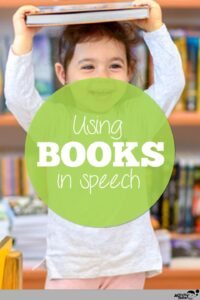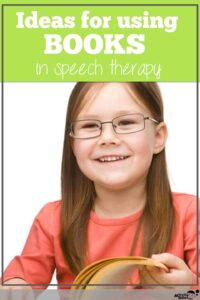Speech-language pathologists know using books is one of the BEST ways to build language, but are often quick to assign that task to caregivers. Our graduate school classes are great at telling us the “why” we should do something but tend to be weaker in the “how.” If you don’t get experience working with another therapist who incorporates books into the therapy room, it’s easy to feel a little uncertain as to how to do it.
The challenges of using books in speech therapy
- It takes a looong time. Most story books are long especially if they are designed for preschool/elementary aged students. It feels inefficient, and it is, to spend 15 minutes reading a story during a therapy session.
- A lot of our students don’t have the experience or attention span to sit and listen to a full storybook. It’s never fun to feel like you’ve lost your audience.
- Most books won’t explicitly target speech goals. You need to get a little more creative.
Why you should you use books in speech therapy
All the same reasons we ask parents to start a read aloud habit pertain to us.
A regular read-aloud habit:
- Builds attention skills
- Builds vocabulary
- Supports oral language (talking)
- Promotes longer sentences
- Develops understanding of sequences and typical story structure
- Teaches inferencing
- Demonstrates advanced grammatical structures
- Is a time for bonding and building rapport!
For a handout to give to parents on the importance of reading aloud, click here.
How to use books in speech therapy
Rather than structuring your session as “first we read our book and then we play with toys,” have books available during play. This gives our little ones the message that books are fun too! By combining toys with books, we up the fun factor even more!
As an Amazon affiliate I may earn a small commission from Amazon links. There is no additional charge to you.
For instance:
- Try pulling out construction vehicles to match to pictures in a “First Trucks” book
- Use farm animals to act out the action in a farm-based book
- Store “first word” books with play sets. Around the home books match with a doll house; zoo animals match with a zoo set.
Another option is to act out the story with toys or yourself. This gives children a “script” they can use especially when working on social communication rather than having them generate dialogue on their own. Gestalt language processors in particular love to learn this way!
Don’t fall into the typical habit of needing to read every word on the page or to finish a book in one session (or ever). One book I love using is Mrs. Wishy Washy’s Farm, but I don’t think I’ve ever made it to the end with a student! We like to read and read and read again the section about bathing the animals and then act it out with our plastic farm animals and a bin of water. In fact, the favorite page talks about soap getting in the eyes of the cow so, more often than not, we use that rhyme with each animal.
Struggling to get your little ones to engage with books or needing some inspiration for incorporating books into therapy? Join me for Engaging Children with Books an on-demand webinar with practical tips and a bonus shopping list.







